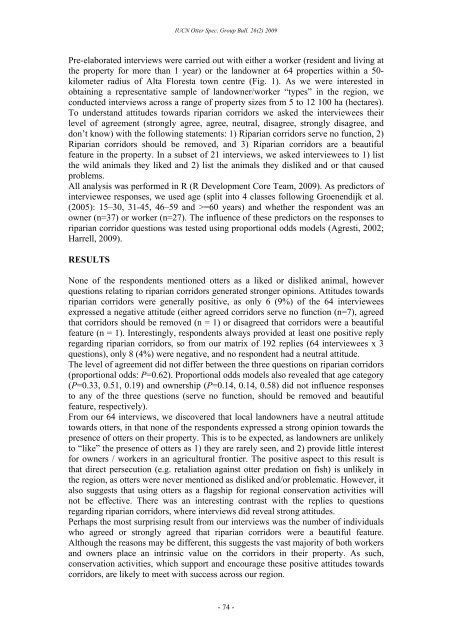Pages (PDF 3 MB) - Otter Specialist Group
Pages (PDF 3 MB) - Otter Specialist Group
Pages (PDF 3 MB) - Otter Specialist Group
Create successful ePaper yourself
Turn your PDF publications into a flip-book with our unique Google optimized e-Paper software.
IUCN <strong>Otter</strong> Spec. <strong>Group</strong> Bull. 26(2) 2009<br />
Pre-elaborated interviews were carried out with either a worker (resident and living at<br />
the property for more than 1 year) or the landowner at 64 properties within a 50-<br />
kilometer radius of Alta Floresta town centre (Fig. 1). As we were interested in<br />
obtaining a representative sample of landowner/worker “types” in the region, we<br />
conducted interviews across a range of property sizes from 5 to 12 100 ha (hectares).<br />
To understand attitudes towards riparian corridors we asked the interviewees their<br />
level of agreement (strongly agree, agree, neutral, disagree, strongly disagree, and<br />
don’t know) with the following statements: 1) Riparian corridors serve no function, 2)<br />
Riparian corridors should be removed, and 3) Riparian corridors are a beautiful<br />
feature in the property. In a subset of 21 interviews, we asked interviewees to 1) list<br />
the wild animals they liked and 2) list the animals they disliked and or that caused<br />
problems.<br />
All analysis was performed in R (R Development Core Team, 2009). As predictors of<br />
interviewee responses, we used age (split into 4 classes following Groenendijk et al.<br />
(2005): 15–30, 31-45, 46–59 and >=60 years) and whether the respondent was an<br />
owner (n=37) or worker (n=27). The influence of these predictors on the responses to<br />
riparian corridor questions was tested using proportional odds models (Agresti, 2002;<br />
Harrell, 2009).<br />
RESULTS<br />
None of the respondents mentioned otters as a liked or disliked animal, however<br />
questions relating to riparian corridors generated stronger opinions. Attitudes towards<br />
riparian corridors were generally positive, as only 6 (9%) of the 64 interviewees<br />
expressed a negative attitude (either agreed corridors serve no function (n=7), agreed<br />
that corridors should be removed (n = 1) or disagreed that corridors were a beautiful<br />
feature (n = 1). Interestingly, respondents always provided at least one positive reply<br />
regarding riparian corridors, so from our matrix of 192 replies (64 interviewees x 3<br />
questions), only 8 (4%) were negative, and no respondent had a neutral attitude.<br />
The level of agreement did not differ between the three questions on riparian corridors<br />
(proportional odds: P=0.62). Proportional odds models also revealed that age category<br />
(P=0.33, 0.51, 0.19) and ownership (P=0.14, 0.14, 0.58) did not influence responses<br />
to any of the three questions (serve no function, should be removed and beautiful<br />
feature, respectively).<br />
From our 64 interviews, we discovered that local landowners have a neutral attitude<br />
towards otters, in that none of the respondents expressed a strong opinion towards the<br />
presence of otters on their property. This is to be expected, as landowners are unlikely<br />
to “like” the presence of otters as 1) they are rarely seen, and 2) provide little interest<br />
for owners / workers in an agricultural frontier. The positive aspect to this result is<br />
that direct persecution (e.g. retaliation against otter predation on fish) is unlikely in<br />
the region, as otters were never mentioned as disliked and/or problematic. However, it<br />
also suggests that using otters as a flagship for regional conservation activities will<br />
not be effective. There was an interesting contrast with the replies to questions<br />
regarding riparian corridors, where interviews did reveal strong attitudes.<br />
Perhaps the most surprising result from our interviews was the number of individuals<br />
who agreed or strongly agreed that riparian corridors were a beautiful feature.<br />
Although the reasons may be different, this suggests the vast majority of both workers<br />
and owners place an intrinsic value on the corridors in their property. As such,<br />
conservation activities, which support and encourage these positive attitudes towards<br />
corridors, are likely to meet with success across our region.<br />
- 74 -
















